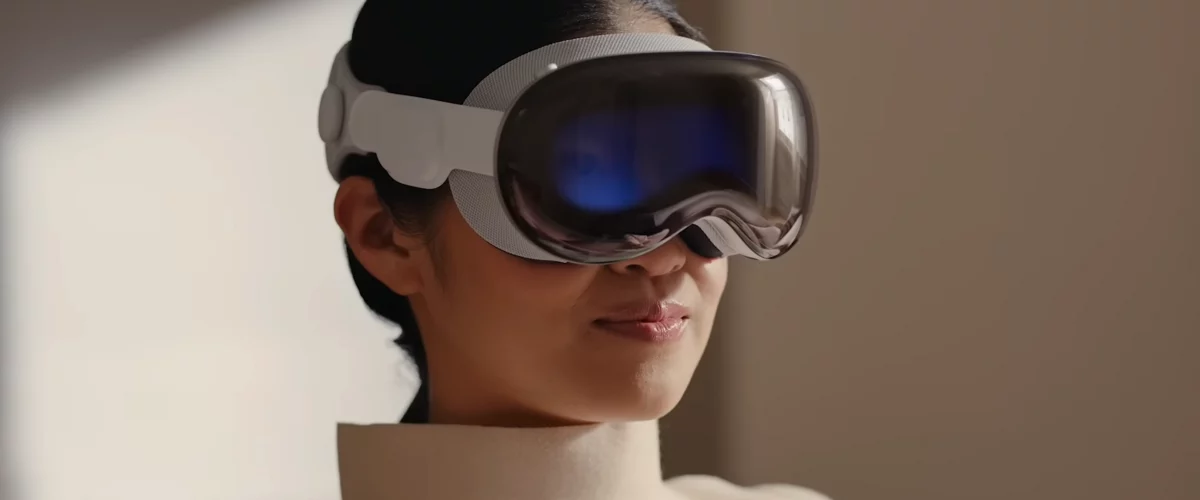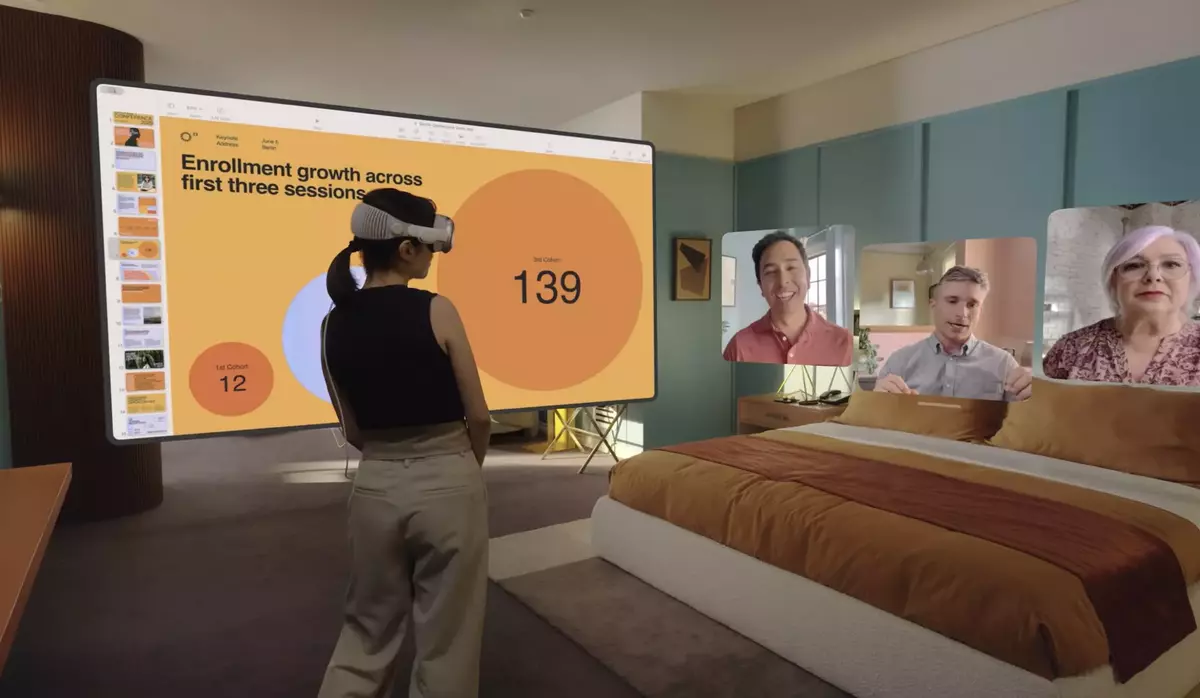Vision (Pro) of the future or unreasonable expectations

Article author :
How about we have a chat about Apple’s eagerly awaited Vision Pro? Just a couple of weeks ago, the brand revealed its upcoming technological revolution. The range of possibilities which this new tool may offer is sending shivers down the spines of everyone intimately or remotely engaged with tech, extended reality and development.
Apple’s announcement regarding its Vision Pro was met with a range of opinions, and not everybody sees eye to eye on the subject. Whilst some are claiming the beginning of a new era of digital consumption, others view this new tool as a gadget which will merely open the wallets of the brand’s consumers.
Always ahead of the game
Since the release of the first Macintosh, Apple has established itself as the leader in terms of technological advances. Acknowledged as the ‘The Greatest Tech Company in the World.’ The hype surrounding its products is not an unexplained phenomenon because the first MacBook clearly defined a new era of nomadic technology. For its part the first iPhone reconfigured our habits in terms of a mobile phone in its mini pocket computer iteration.
With its ability to put together functionalities and offer ergonomic and ultra-intuitive UI and UX (Users interface & users experience), the American brand has shattered the codes on numerous occasions. And it is legitimate to wonder if the Vision Pro will do the same as its adelphs (a non-gendered term to denote a fraternity or a sorority).
Remaining true to itself, Apple has presented a pared down, very fine and elegant product which at first glance seems comfortable. But is it solely that which distinguishes it from other extended reality (extended reality includes augmented reality, mixed reality and virtual reality) headsets already on the market, such as HTC Vive Pro, Oculus Quest, Pico, etc. (VR), Hololens (MR))?
As Elias Oumouadene, an innovation consultant at Tomorrowlab, puts it so well, it is ‘Apple’s ability to present it to us without ever talking to us about either virtual reality or artificial intelligence or the metaverse.’ Defining itself rather as an augmented reality headset, the Vision Pro offers a very different experience to that of a ‘standard’ virtual reality headset or a Hololens (the Microsoft mixed reality headset, primarily used in work-related areas, industry and training). One of the principal characteristics by which it stands out is the quality of the extended reality, produced thanks to the dozen or so 3D cameras with which the headset is equipped and the very personally customised audio spatialisation. The precision of the cameras and the eye tracking grants us the liberty to handle the different interfaces thanks to our viewpoint and the gestures of our hands. They also produce ultra-accurate meta-humans for all our FaceTime sessions and visual calls. The possibility of regulating the screen’s transparency via a setting wheel will vary the headset’s degree of immersiveness, but will also eliminate the inner ear problems and nausea experienced by a proportion of its users. With an aluminium chassis, the headset promises a certain lightness and delicacy which will allow it to be kept on one’s head for a more extended time than its cousins at HTC or Meta.
Besides the extended reality experience, the Vision Pro offers the first spatial computer combined with a smartphone and a home cinema complex. As was mentioned earlier, Apple is pushing digital consumption to its very edge in combining the functionalities of our everyday tech equipment. This new revolution will allow us to replace the stock of our digital tools with a single device.
Are we once again in a new era of technological advances? Does the arrival of this XR headset mark the beginning of new tech use practices, in the same way that the preceding Apple products did?
A double-edged revolution
We can perhaps all concur that this announcement is sending shivers down the spines of the competition and fans of the Steve Jobs brand alike … but several questions nonetheless remain. Why isn’t the Vision Pro as revolutionary as it claims to be? The combination of functionalities is actually a brilliant idea, but will involve wearing the headset on one’s head non-stop (if, as we are, you are ultra-connected), which may represent a more than prohibitive argument for multiple reasons. First of all, our brains are not accustomed to dealing with a screen so close to our eyes for an extended period. For those who have already had the opportunity to experiment with VR in total immersion, prolonged consumption of this type of device can rapidly become problematic for our eyes, our stomachs (we won’t lie to you, over 20 minutes in a headset and a number of us are overcome by headaches and nausea) and our necks (to be challenged with the aluminium chassis). Once again, the transparency and the screen’s 23 million pixels could very well prove us wrong.

Two supplementary questions are thereby raised. The first concerns the autonomy of the battery. Apple announced that it could keep going for two hours BUT that we could plug the headset into an external battery… If the wish is to combine our smartphones, laptops and televisions, this autonomy may create difficulties. The second unresolved question concerns its isolating effects. VR is often critiqued owing to the fact that it shuts individuals away and, moreover, that large-scale use of VR in the household doesn’t convince everyone. The Vision Pro’s presentation video offers us a Black Mirror style use of the headset, promising frequent contact with our friends and family by means of meta-humans and a scrolling through of our photo galleries experienced fully in 3D. For the Vision Pro, we will be able to choose the degree of immersion, but how will we be able to watch a film with a friend?
Money money money
With an announced price of 3,500 Euros, the Vision Pro beats the Hololens, but exceeds by far the virtual headsets currently on the market. Yet the price makes it inaccessible for the majority of consumers. Who is Apple’s target audience? As Desmond Cureton says in his article for XRToday,’[simultaneously aiming] for both consumers and enterprise end users will avoid “white elephant” syndrome, where massive, expensive projects are simultaneously impressive to audiences but ultimately impractical, or worse, infeasible.’ This wish to provide for the general public is a risky gamble because both for the useful functionalities and the projects to be consumed, not everyone will find what they are looking for. By aiming to turn it into a flagship product and the absolute ‘must-have’, the worry is over the social and economic divide which high-tech already constitutes.
Nearly all of the Apple products include several versions, available (or not) in terms of the budget. ‘However, Apple will need close to a decade to bring down its price point for mass adoption before developers can begin extrapolating a functional ecosystem for it,’ explains Demond Cureton.
Despite the arguments that what we have here is a first version and that the follow-up promises a more affordable range for individuals, are we really ready to renounce our habits in order to use solely this tool? Some people are talking about the price range of Apple products, which already makes people pay a month’s rent or even two for a telephone. Will the little apple once again flash its brightest smile to convince its consumers to buy a product which will require a period of time to adapt to? After the Apple Watch and the AirPods, amongst others, we will have to wait until 2024 to see if their marketing coup has succeeded.
Revolution or an uncertain gamble?
Without knowing the answer, not having been able to already trial the headset, the announcement concerning Apple’s Vision Pro remains a unique moment. Maybe we could get together again in 10-15 years to contemplate this new chapter which Apple has just opened. After having made wired headphones obsolete, the brand is promising much. And we will have to wait until 2024 before people (having been able to give themselves the luxury, it must be clearly said) can confirm it.
Offering an innovation at the cutting edge of technology and combing functionalities which have never been brought together, can we compare the incomparable? In the end, the Vision Pro resembles no currently available equipment. It remains to be seen if it will find its audience.
A story, projects or an idea to share?
Suggest your content on kingkong.




